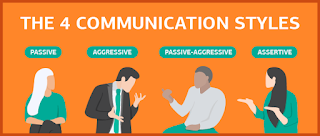Understanding Communication Styles
What is your style?
The ways we present ourselves says a lot about us. The way we dress, the way we speak, the way we behave with others affect our relationships not only with others but also with ourselves.
We have patterns and habits of how we communicate with others. We adopt unique communication styles which reflect on our mood, personality as well the type of conversation we have with people.
Each person has a unique communication style. These communication styles come under four broad categories: Passive, Aggressive, Passive-Aggressive, and Assertive. Understanding different communication styles can improve the quality of our relationships with others.
Let’s understand 4 types of communication styles.
Passive
Have you noticed some people who constantly say, “It really doesn’t matter” or “I don’t like confrontation” or “I want to keep the peace?” These are some of the things people with passive communication style say.
In the passive communication style, people usually don’t express their needs and desires; they don’t take a stand for their rights and are usually indifferent to what others say. A passive communicator prioritizes their needs, wants, and feelings of others, even at their own expense.
People with passive communication styles do not express and hence, let their issues mount up. Such a person, after reaching their threshold of tolerance, may experience explosive outbursts which are usually out of proportion to triggering events.
Passive communicators often fail to make eye contact while talking, they usually have a poor posture and are usually not able to say “No.” They often lack confidence and have low self-esteem.
Aggressive
Have you ever been bullied by your boss? Have you been in an argument where your rights were violated or you were interrupted while you spoke?
Aggressive communication style lies on the other end of the continuum. These people are concerned about only their needs, wants, and feelings. They often express their feelings, wants, needs, etc. in ways that violate the rights of others.
In aggressive communication styles, the person speaks loudly, maintains intense eye contact, often try to dominate or control the other person by blaming, intimidating, criticizing, etc.
Aggressive communicators usually have low frustration tolerance. They are very impulsive and do not listen well. They will often speak in a loud, overbearing voice and behave in a rude or threatening manner.
Passive-Aggressive
Passive-aggressive communicators appear to be passive on the surface but they may feel powerless or stuck and act out anger in indirect, subtle, or discreet ways. They feel incapable of dealing directly with the objects of resentment.
Passive-aggressive people are aware of their needs but often struggle to voice them. They also face difficulty acknowledging their anger. They may appear to cooperate, but may silently be doing the opposite. Passive-aggressive communicators may engage in activities like giving someone silent treatment, spreading rumors behind people’s back, or sabotaging other’s efforts.
Often their body language and facial expressions are incongruent with their thoughts and feelings. For example, a passive-aggressive person might be smiling when they are angry.
Assertive
Assertive communication is considered to be the most effective form of communication. Assertive communicators can express their feelings, emotions, needs, thoughts in ways that do not violate the rights of the others. They are mindful of other people’s needs, emotions, thoughts, and rights.
Assertive people value themselves, their time, their emotional, physical, and spiritual needs. They are usually able to take stand for their rights. Assertive people often use “I” messages while talking. They maintain eye contact and are usually calm and relaxed while communicating.
Many can argue - not many converse
A. Bronson Alcott
So, what is your communication style? Tell us about it in the comments.



Comments
Post a Comment